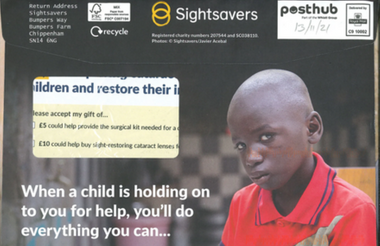Images of Africa are overrepresented in UK-based international development charities’ direct mail campaigns, according to new research.
Published this week, Charity Representations of Distant Others found “some potential disconnect” between the countries featured in the campaigns’ imagery and the areas where the charities work.
Charity Advertising’s report authors warned that overrepresenting African countries could “reinforce deeply entrenched associations between Africa and poverty”.
The report’s authors examined 589 images across 31 mailouts from nine UK-based charities, including CARE International, Oxfam and Save the Children, between March 2021 and March 2022.
They found that Africa continues to visually dominate charities’ direct mail communications, with 51% of the images analysed featuring African countries.
This is despite the UK being the most represented country (81 images), accounting for 12% of the subject matter, “cumulatively more than all other subject matters apart from health”, the report says.
Deborah Adesina, co-author of the report, said: “Despite working in multiple regions, many charities continue to overrepresent Africa – a trend that raises questions about narrative authenticity.
“Our research shows that for some charities, the high volume of African imagery didn’t necessarily align with the number of African countries they work in.”
The report follows another Charity Advertising study published last year that focused on international development charities’ newspaper adverts and similarly concluded that African countries were overrepresented.
Images risk reinforcing ‘outdated stereotypes’
The research published this week analysed several 2021-22 annual reports to compare the areas where charities worked and those used in their campaign imagery.
They found “some potential disconnect”. For instance, Christian Aid used 68 images of Africa (72% of its total) but worked in 14 countries, only half of which were African.
“These findings suggest that charities’ communications risk amplifying visual representation from Africa beyond what their operational footprint would suggest,” the report says.
“This raises important questions about the motivations underlying these choices. Are charities prioritising narratives from Africa because they believe these images carry a stronger emotive impact on donors, and in so doing reinforce deeply entrenched associations between Africa and poverty?”
The report says such choices also pose ethical challenges, as they may inadvertently marginalise other regions where significant work is conducted, “reducing their visibility in donor consciousness”.
“Furthermore, these practices can perpetuate a transactional view of humanitarian work, wherein the depiction of suffering becomes a tool to secure funding, rather than a medium to cultivate an enlightened donor base with a deeper understanding of how development works,” it reads.
“By contrast, it diminishes the agency and dignity of the communities being represented.”
It adds that the overuse of African imagery “risks reinforcing outdated stereotypes of the continent, overshadowing its progress and diverse realities”.
Fewer ‘pitiful’ images than in newspaper ads
The report says that health remains the most significant subject matter represented in direct mail, accounting for over one-third of all images, compared with over two-thirds of newspaper adverts.
It warns that people from the Global South are overwhelmingly positioned “as consumers and passive recipients of care, neglecting narratives around training local staff or investing in infrastructure to build self-sustaining health systems”.
Meanwhile, nearly three-fifths of the images depicted women, children or both from the Global South.
Nine direct mail campaigns featured fathers and their children, more than in newsletter ads, while more young people from the developed world were also included.
Four direct mail campaigns (less than 1%) included “pitiful” or shock-inducing images of people, the research found, compared to 11% of the newspaper ads it previously studied.
Related articles











